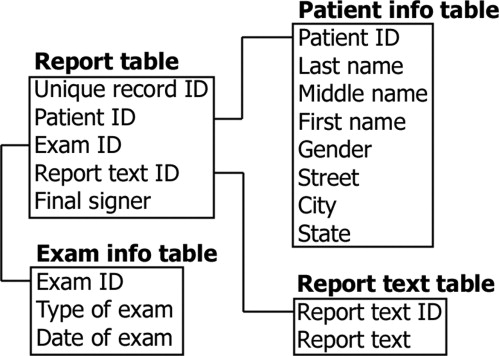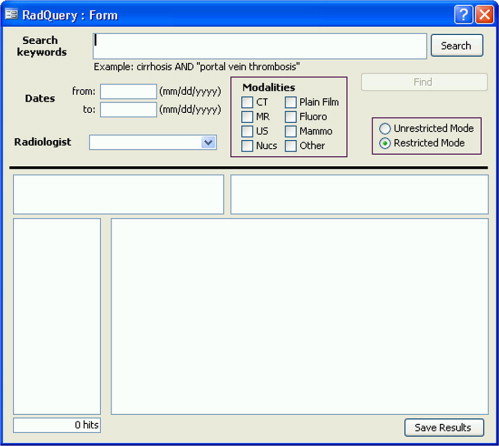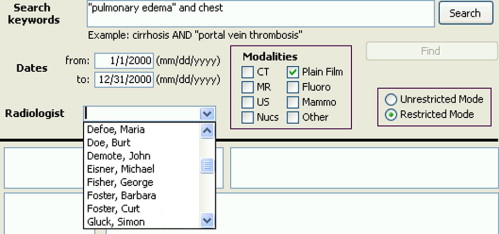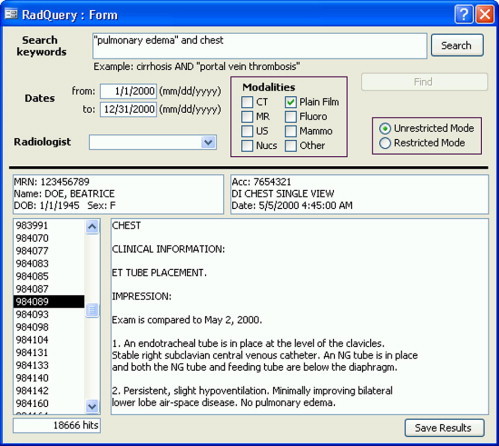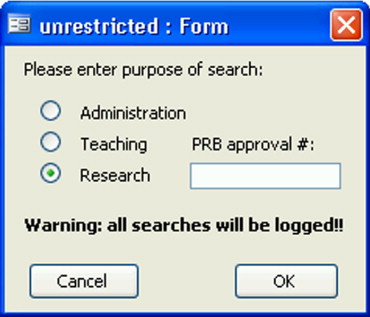Rationale and Objectives
We present a method to perform full text searches of radiology reports for the large number of departments that do not have this ability as part of their radiology or hospital information system.
Materials and Methods
A tool written in Microsoft Access (front-end) has been designed to search a server (back-end) containing the indexed backup weekly copy of the full relational database extracted from a radiology information system (RIS). This front end-/back-end approach has been implemented in a large academic radiology department, and is used for teaching, research and administrative purposes.
Results
The weekly second backup of the 80 GB, 4 million record RIS database takes 2 hours. Further indexing of the exported radiology reports takes 6 hours. Individual searches of the indexed database typically take less than 1 minute on the indexed database and 30–60 minutes on the nonindexed database. Guidelines to properly address privacy and institutional review board issues are closely followed by all users.
Conclusions
This method has potential to improve teaching, research, and administrative programs within radiology departments that cannot afford more expensive technology.
Modern radiology departments make extensive use of information technology. Basic computer workstations with displays are used to review images, and are part of a Picture and communication archiving system (PACS) that distributes the images throughout a department or an institution. Dictation of radiology reports is commonly performed with voice recognition software that minimizes the need for transcriptionists and reduces the time from exam completion to availability of the final report ( ). A large computer infrastructure, the radiology information system (RIS) contains all the patient and radiology exam information, including final radiology reports and administrative information, such as billing. All these systems are interrelated to produce an efficient modern work environment. Many of the administrative and clinical needs of a modern radiology department are addressed by these systems. However, these systems often fail to address some specific information technology needs of the radiologists, particularly related to teaching, quality assurance and research. Sometimes these needs are met by a larger hospital information system, but often they are not.
RIS
A RIS is used to store, manipulate and distribute information about the patients, their radiologic exams, and the resulting images. A RIS usually contains information about patient registration, tracking, scheduling and billing, information about radiology reports including the text of the reports themselves, and information about tracking of images. The images themselves are usually not stored in the RIS but on the PACS. The RIS usually has a health level 7 interface with the PACS to associate reports with images and quickly retrieve prior reports when a radiologist interprets images on the PACS.
Get Radiology Tree app to read full this article<
Get Radiology Tree app to read full this article<
SQL
Get Radiology Tree app to read full this article<
Get Radiology Tree app to read full this article<
Get Radiology Tree app to read full this article<
Purpose
Get Radiology Tree app to read full this article<
Material and methods
Get Radiology Tree app to read full this article<
Back-End Server
Get Radiology Tree app to read full this article<
Get Radiology Tree app to read full this article<
Get Radiology Tree app to read full this article<
Get Radiology Tree app to read full this article<
Get Radiology Tree app to read full this article<
Front-End Client
Get Radiology Tree app to read full this article<
Get Radiology Tree app to read full this article<
Get Radiology Tree app to read full this article<
Get Radiology Tree app to read full this article<
Results
Back-End Server
Get Radiology Tree app to read full this article<
Front-End Client
Get Radiology Tree app to read full this article<
Get Radiology Tree app to read full this article<
Get Radiology Tree app to read full this article<
Search Results
Get Radiology Tree app to read full this article<
Get Radiology Tree app to read full this article<
Discussion
Get Radiology Tree app to read full this article<
Search Contexts
Get Radiology Tree app to read full this article<
Get Radiology Tree app to read full this article<
Get Radiology Tree app to read full this article<
Security, Privacy, and IRB Issues
Get Radiology Tree app to read full this article<
Get Radiology Tree app to read full this article<
Get Radiology Tree app to read full this article<
Get Radiology Tree app to read full this article<
Limitations
Get Radiology Tree app to read full this article<
Conclusion
Get Radiology Tree app to read full this article<
References
1. Marquez L.O.: Improving medical imaging report turnaround times. Radiol Manage 2005; 27: pp. 34-37.
2. Codd E.F.: A relational model of data for large shared data banks. CACM 1970; 13: pp. 377-387.
3. Chamberlin D.D., Boyce R.F.: SEQUEL: a structured English query language.1974.pp. 249-264. Proceedings of the 1974 ACM SIGFIDET workshop on Data description, access and control. Ann Arbor, Michigan
4. Viescas J.L.: 2003.Microsoft PressRedmond, WA
5. US Code of Federal Regulations, Title 45, Volume 1 Part 164 Subpart E (revised October 1, 2005): Privacy of individually identifiable health information (45CFR164).
6. US Code of Federal Regulations, Title 45, Volume 1 Part 46 Subpart A (Revised October 1, 2005): Basic HHS Policy for protection of human research subjects (45CFR46).
7. Chew F.S.: Evaluation of clinical experience in a radiology residency program with quantitative profiling: rationale, methods, and application. Acad Radiol 1999; 6: pp. 102-111.
8. Lee S.I., Chew F.S.: Radiology in the emergency department: technique for quantitative description of use and results. Am J Roentgenol 1998; 171: pp. 559-564.
